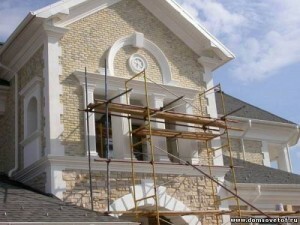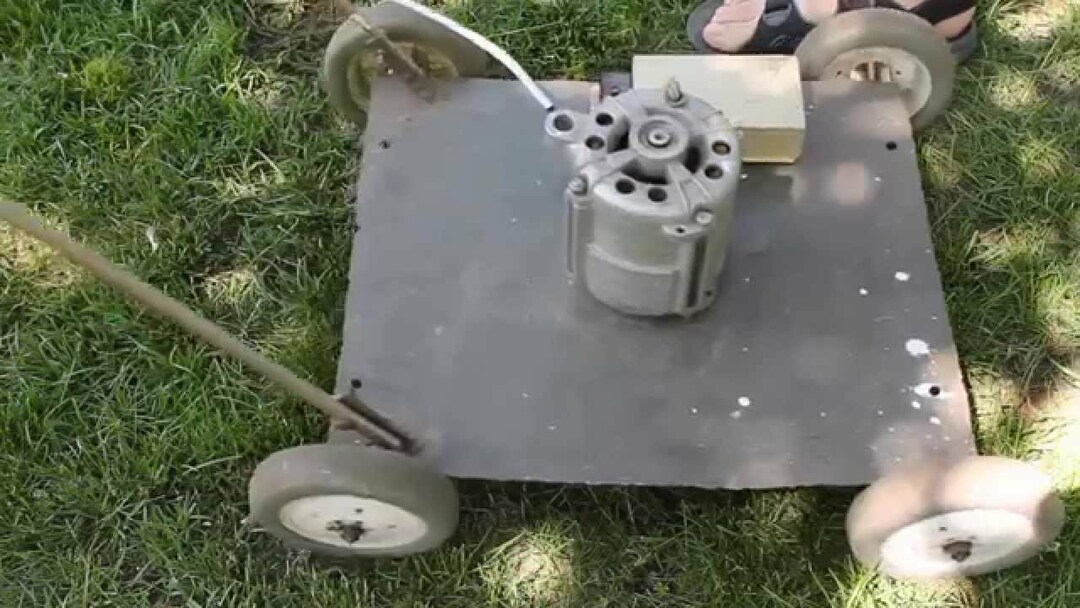Caisson for the cellar: selection criteria and features of the installation
Table of contents
- 1 Technical characteristics of the cellars
-
2 Differences from the conventional caisson cellar
- 2.1 Varieties of caissons for cellars
-
3 Features cellar caisson installation
- 3.1 Installation in a pit
- 3.2 Waterproofing outer walls
- 3.3 Warming sunken caisson
- 4 conclusion

Coffered vault of plastic can replace the design of metal or concrete.
What is the concrete or plastic caisson to the cellar? Let's find out what are the different varieties, what to look for when choosing, as well as explore the features of the installation repository.
Technical characteristics of the cellars
What parameters are interested owner sunken cellar?
- Air temperature. In the summer should be 5-7 ° C with a plus sign, and in the cold time of the year should not fall below 2-4 ° C;
- Relative humidity. In the range of 80% to 95%. At lower values of vegetables will quickly fade and lose moisture, and higher values may contribute to the development of putrefactive bacteria and mold;
- Water resistant. Any underground cellar must be completely sealed construction, so as not to be flooded during spring floods, heavy rains or the seasonal increase in the groundwater level;
- Ventilation. For long-term storage of fruits and vegetables a basement should be equipped with forced ventilation;

The diagram shows the air circulation process of a properly designed ventilation.
- Reliability and durability.

The table indicates the allowable temperature deviation when the actual relative humidity and air temperature.
Until recently, all buried cellars and basements were made solely on the traditional classical scheme:
- subfloor. In sandy soil conditions and low groundwater table (groundwater level) in the cellar floor usually leave ground. At high GWL subfloor mounted monolithic concrete slab or stacked several layers of rawhide compacted clay;
- The side walls. For the manufacture of the side walls recessed cellar often used masonry brick or stone quarry to the cement-sand mortar;
- The ceiling. As an overlap commonly used ready-made concrete slabs, arched vaulted ceiling, or dialer overlap on wood, metal or concrete beams;
- Entry group There are two types. The first of these is a round or square with insulated hatch cover and a ladder. In the second case near the cellar is equipped with a separate entrance door, which is built helical or straight stairway with steps.

Construction recessed brick cellar with a stairway.
Differences from the conventional caisson cellar
Ready caisson cellar construction is absolutely hermetic vessel with durable waterproof outer walls. They are produced in different sizes and are usually made in the shape of a cylinder, a parallelepiped or cube. In the original equipment caissons equipped with insulated entrance hatch, internal staircase, stacked shelving and storage systems for a variety of products.
Enumerate differences cellar caisson type compared to conventional underground cellar:
- Time and complexity of manufacturing. Work on the construction of a brick cellar can be considered a full-fledged construction site. You will need to purchase building materials and equipment, to hire specialists in laying bricks, and over time this construction will be delayed for at least 1-2 months;
- Easy installation. Caisson chamber cellar is sold fully ready for use, and equipped with all the necessary infrastructure (entrance, ventilation, stairs, storage, etc.). For its installation will only need the earthworks, so the time for installation of the box need not more than one week;
- Save space. For the construction of the classic underground cellar is required to allocate a separate place on your site. To save space, the cellar caisson can be installed directly in a private house, a shed or under a summer kitchen;
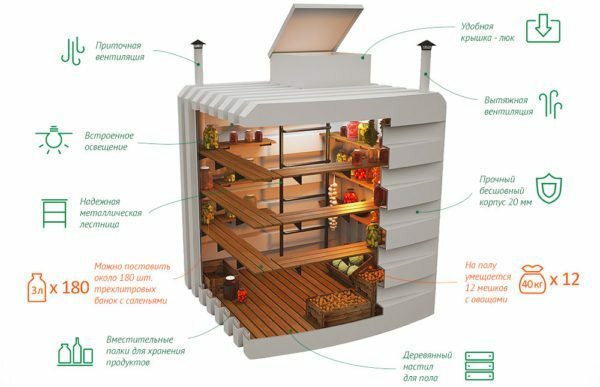
General appearance and internal structure of caisson cellar producer with explanations about the technical parameters of the internal filling.
- Flooding of cellars. The traditional construction of cellars have many weak points through which water can get inside - the joints of the walls, floor and ceiling, cracks in the brickwork, the gaps between the floor slabs, etc .;
- Sealing and waterproofing. Decompression container is fully sealed structure. The main condition - the water does not penetrate through the ventilation system;
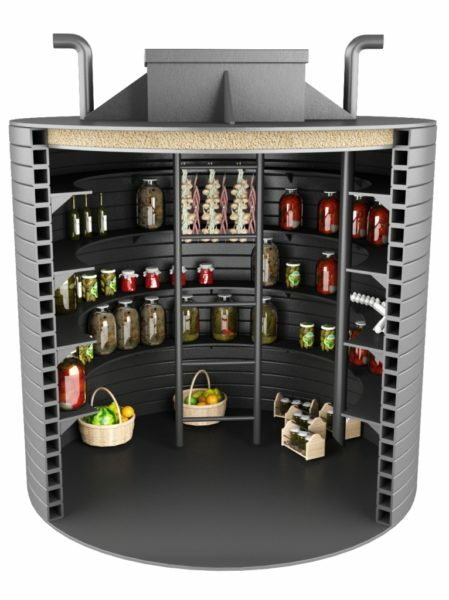
Apparatus caisson cylindrical shape. Which option to choose - you decide.
- Low strength. Blurring and subsidence of the soil or soil lateral motions lead to cracking or partial destruction of a concrete slab and masonry;
- Resistance to dynamic loads. Factory caissons for cellar made of elastic materials with high toughness. For this reason, they lend themselves well to plastic deformation and do not collapse under the influence of ground motion and other dynamic loads;
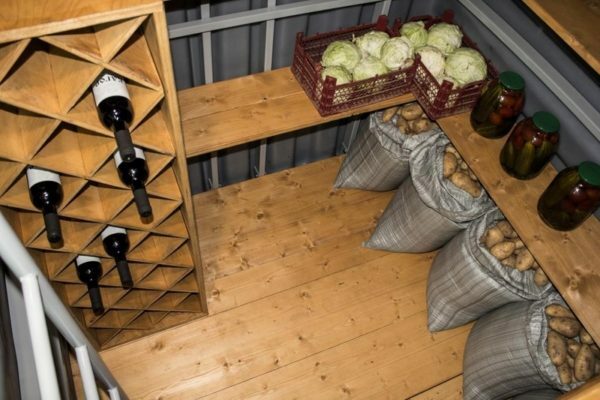
Storage racks are specially treated to protect them against moisture.
- Especially construction materials. Concrete slabs and brick walls have a rough surface with deep-porous structure that facilitates penetration and retention of moisture and absorb odors and conservation;
- Compliance with sanitary norms. Inner wall caisson chambers are made of ecologically safe materials which have a smooth uniform surface;
- Cost. At first glance, the price of the finished caisson may seem quite high. Despite this, its installation and maintenance will cost much cheaper than building the usual recessed cellars of brick and concrete.

Plastic caisson with a sloping stairway.
To the cellar in the classic mold is not formed, it should be every summer to dry, and then whitewash the walls and ceiling of lime milk with the addition of copper sulfate. Recessed wall caisson cameras do not require any additional processing inside.
Varieties of caissons for cellars
In most commercially available can be found ready caisson cellar container of plastics based on polyethylene or polypropylene. With self-manufacturing it can be made from heavy black metal, prefabricated concrete rings for wells or reinforced with reinforced concrete.
Comparative characteristics of the caissons of different materials:
- Plastic caisson. Such mozhnoizgotovit caisson as a hollow upright cylinder or a cube of thickness of the outer walls of 10 to 22 mm:
- So it does not deform under the influence of ground pressure on all side faces are transverse and longitudinal stiffeners;
- Inside the shell is a plastic base plate welded steel profile pipes. It provides additional rigidity and serves as the basis for fixing the shelves, racks and other storage systems.
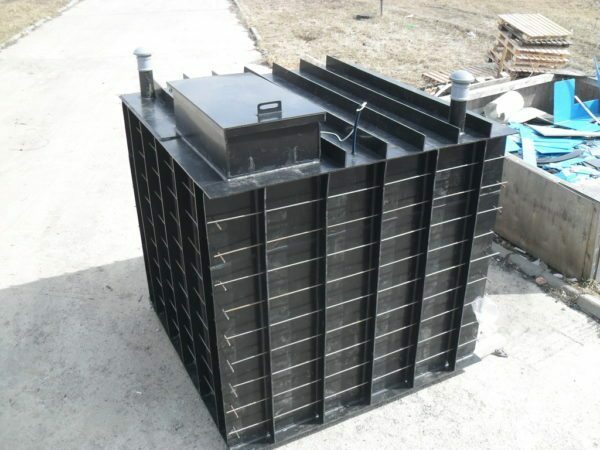
On the side faces visible ribs. Their number is calculated under various loads.
- Caisson of metal. Metal container for buried cellars made of black steel sheet thickness from 8 to 20 mm:
- Most often they are in the form of a cube, parallelepiped or a vertical cylinder;
- To enhance the metal caisson from the outside of the housing are welded longitudinal ribs of thick steel strips;
- Mounted inside a metal staircase and outside welded to the vertical entrance hole with a fitting insulated hatch cover.
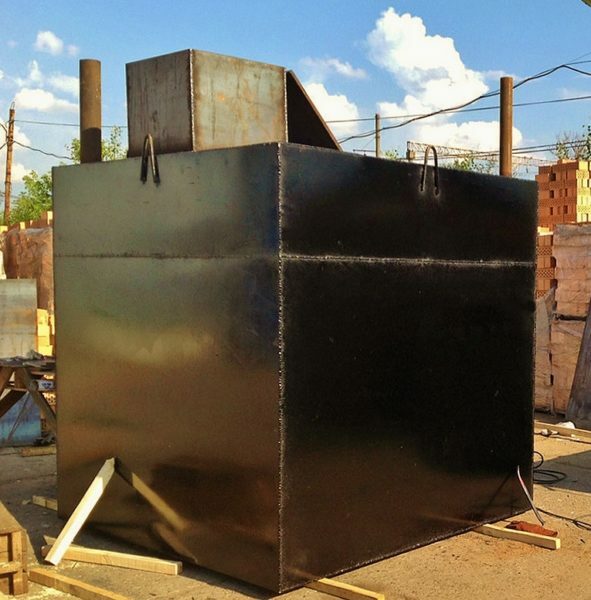
Welded capacity will still be processed protective compounds that protect the metal.
- Caisson of reinforced concrete. Such structures are typically made in the event that there is no possibility to get a suitable decompression finished container of plastic or metal. Monolithic concrete caisson is made in several stages, directly into the pit:
- Initially, the prepared sand-gravel cushion filled with reinforced concrete slab foundation;
- Then mounted vertical shuttering, it is set in steel reinforcement, after the space between the formwork is filled with a liquid concrete mortar;
- After solidification of concrete walls, mounted inside the horizontal shuttering, reinforcement is placed, then poured ceiling and floor elements of the input group.

Filling the walls of reinforced concrete in the pre-assembled formwork.
This technology is quite complex and time-consuming, so the individual building it is used infrequently.
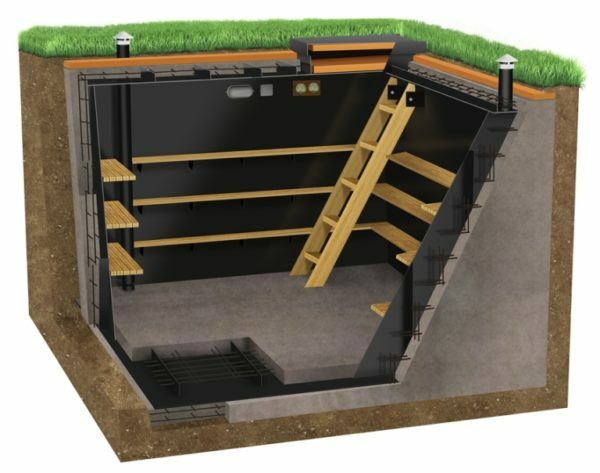
Features cellar the caisson of reinforced concrete is much luchshechem a traditional cellar
- Caisson of concrete rings. A simpler version of the container is made of concrete rings, which are commonly used in the construction of wells. The diameter of the ring must be at least 1500-2000 mm. Manufacturing technology of the cellar is quite simple:
- At the bottom of the pit is set round solid plate, or a special lower ring in the form of a cup with a closed bottom;
- On it is mounted through another concrete ring, and the top is laid round concrete cover with an opening;
- To produce the input manway used one or two rings with diameter 700-1000 mm. They are mounted above the opening of the top cover so that the upper plane of the upper ring was located at 200-300 mm above the ground level.

You can use this scheme for the production of concrete rings from the box on their plot.
Benefits:
- cheap materials. Concrete ring can be relatively inexpensive to purchase on the basis of any construction, but by the time the installation of the caisson of the rings will take no more than 1-2 days.
Disadvantages:
- The need for lifting equipment. All components are heavy, so you need to use for the construction of the crane;
- The need for waterproofing. Over time, the joints of the rings can be formed cracks and crevices, which can seep into the water cellars.

The photo shows the entrance hole of the purchased items to buy that is not difficult.
Coffered plastic containers have a sufficiently large volume and very small specific weight. Because of this, with increasing GWL they will tend to "float" up from the ground by the force of Archimedes. To avoid this, light volumetric capacities need to fix the anchor from the bottom to a heavy concrete slab.
Features cellar caisson installation
Installation in a pit
Below is a step by step instructions for installing the metal and plastic cellar at the site.
| Illustration | Description of work |
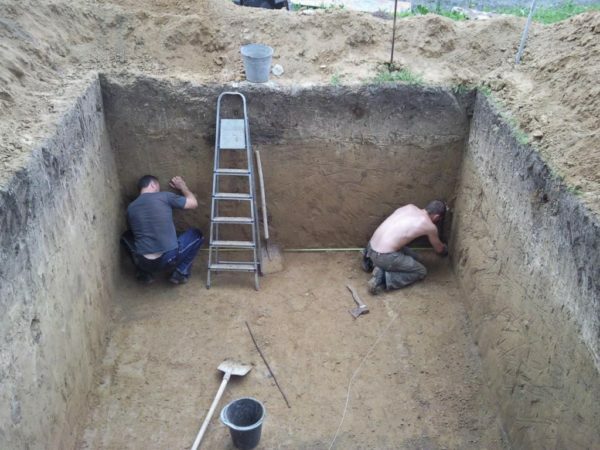 |
Excavation. Primarily in a selected area of land needed to perform layout, remove the fertile upper soil layer of 200-230 mm thickness and dig a pit. The dimensions of the pit, the plan should be such that each side he get to 500 mm larger than the dimensions of the box. The depth of the excavation must be such that after installation of the caisson its upper plane is situated below the maximum depth of soil freezing for your region. |
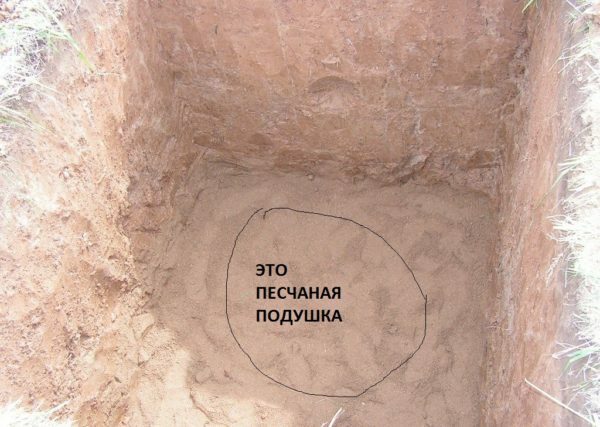 |
Sand bed. The soil at the bottom of the pit needs a little moistened with water and thoroughly compacted. Then pour a pad of sand and gravel and distribute it over the entire area even layer about 200 thick. If at a depth from the ground is already beginning to seep into the water, the sand under the pillow to be stacked several layers of rawhide clay mixed with chopped straw. |
 |
Production base. To caisson during operation does not Skewing and shifted to the side, his base is necessary to lay a concrete slab. The same plate will serve as holding anchors. If there are no suitable size slab, it can be made on the spot. For this:
complete concrete maturation period is 28 days, but to work with such a plate can be after one to two weeks after potting. |
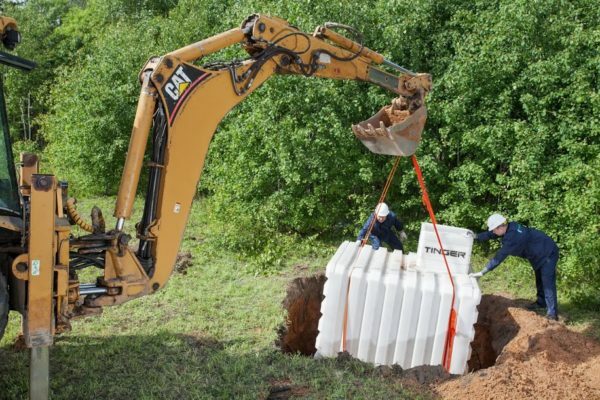 |
Installation of the crane. If you have such a possibility, it is better to use for running the crane, wheel loader or an excavator bucket. For rigging necessary to use wide textile slings. If this is not possible, then lower the caisson in the pit, you can manually. Depending on the weight and volume of the chamber for this we need 3-4 people. |
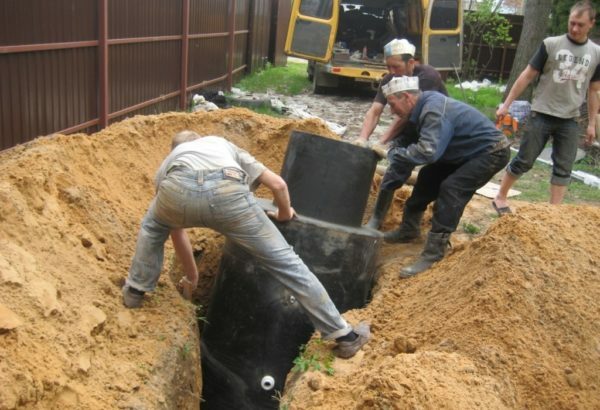 |
Manual installation. To install the caisson vertically exactly in the center:
|
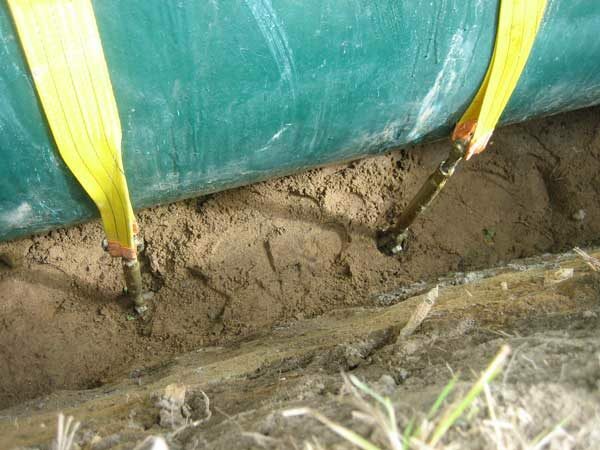 |
Anchoring. To coffered vault is not squeezed out of the ground during lifting GWL, it must be a few points to secure the slab concrete base:
|
If you can not find a 3-4 assistants, I recommend getting an electric or manual winch carrying capacity of not less than 400-500 kg. In this case the installation of the box can be done together. In this case, one person has to guide and align it in the pit and the second pit gradually cable winch.
Waterproofing outer walls
If your body the box is made of plastic, it can skip this section. Metal and concrete caisson is required outside of the container cover waterproofing layer, otherwise they will leak, and their walls after a short time begin to fail.
Next, I'll show you how to do it:
| Illustration | Description of work |
 |
Preparation of the mastic. As a waterproofing composition for metal surfaces, use a heated bitumen mastic. It is easy to cook on the spot. This will require building bitumen and unleaded petrol:
|
 |
Waterproofing caisson of metal. Before working a metal container must withstand the sun, or to heat by a gas burner.
|
 |
Waterproofing concrete caisson. Outdoor water cellars of concrete protection is similar to the metal. The difference lies in the fact that all the work will have to perform on the spot, directly in the pit. In addition to bituminous mastic concrete body can be covered by one or two layers of roofing material. |
To waterproofing materials well grappled with the housing, the caisson should be heated to a temperature at least 40 ° C. Therefore, I advise you to carry out such work in the summer on a hot sunny day. Bituminous mastic is inflammable, so it is necessary to prepare and warm up in compliance with the fire safety rules.
Warming sunken caisson
Earth itself has good insulating properties, and therefore in temperate latitudes warm cellar recessed insulation is not required. When installing a caisson in cold regions can be further insulate the outside.
| Illustration | Description of work |
 |
Backfilling. For the insulation of the side walls when the backfill can use coal slag. It not only possesses low thermal conductivity but good draining properties, therefore, can take from cellar rain and melt water. |
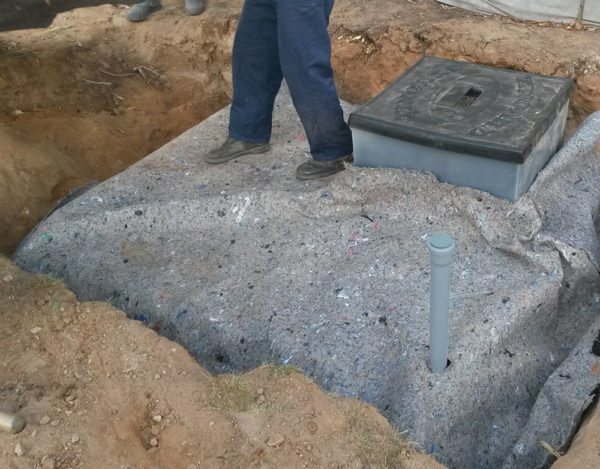 |
Thermal insulation. Earth begins to freeze from the top, so for thermal insulation on top of the body of the box to be stacked in multiple layers of geotextile fabric. You can then perform the final backfill the excavated soil. |
It may happen that you will not be able to install the caisson below the depth of soil freezing. In this case it is possible to use sheets or extruded polystyrene foam (Epps) for insulating cellar.
conclusion
After reading this material, you can pick up for your site suitable for caisson cellar easily. There is also described in detail the entire assembly technology. Further information can be obtained from the attached video in this article, and all the questions can be discussed in the comments.
